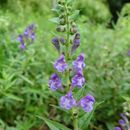Comments
provided by eFloras
Traditionally used as a febrifuge, for relieving fever, and diminishing inflammation. This is one of the most commonly collected species in China.
- license
- cc-by-nc-sa-3.0
- copyright
- Missouri Botanical Garden, 4344 Shaw Boulevard, St. Louis, MO, 63110 USA
Description
provided by eFloras
Herbs perennial. Rhizomes fleshy, to 2 cm in diam., branched. Stems ascending, (15-)30-120 cm tall, much branched, subglabrous or antrorsely to spreading puberulent. Petiole ca. 2 mm, puberulent; leaf blade lanceolate to linear-lanceolate, 1.5-4.5 × (0.3-)0.5-1.2 cm, papery, glab-rous or sparsely puberulent, abaxially densely impressed glandular, base rounded, margin entire, apex obtuse. Racemes terminal, 7-15 cm; basal bracts similar to stem leaves, upper ones ovate-lanceolate to lanceolate, 4-11 mm, subglabrous. Pedicel ca. 3 mm, puberulent. Calyx ca. 4 mm, ca. 5 mm in fruit, densely puberulent outside, margin ciliate, glabrous inside; scutellum ca. 1.5 mm, ca. 4 mm in fruit. Corolla purple-red to blue, 2.3-3 cm, densely glandular pubescent outside, pubescent on saccate part inside; tube conspicuously bent near base, throat to 6 mm wide; middle lobe of lower lip triangular-ovate, ca. 7.5 mm wide. Nutlets black-brown, ovoid, ca. 1.5 × 1 mm, tuberculate, adaxially umbonate near base. Fl. Jul-Aug, fr. Aug-Sep.
- license
- cc-by-nc-sa-3.0
- copyright
- Missouri Botanical Garden, 4344 Shaw Boulevard, St. Louis, MO, 63110 USA
Distribution
provided by eFloras
Gansu, Hebei, Heilongjiang, Henan, Hubei, Jiangsu, Liaoning, Nei Mongol, Shaanxi, Shandong, Shanxi [Japan, Korea, Mongolia, Russia]
- license
- cc-by-nc-sa-3.0
- copyright
- Missouri Botanical Garden, 4344 Shaw Boulevard, St. Louis, MO, 63110 USA
Habitat
provided by eFloras
Sunny grassy slopes, waste and cultivated areas; 100-2000 m.
- license
- cc-by-nc-sa-3.0
- copyright
- Missouri Botanical Garden, 4344 Shaw Boulevard, St. Louis, MO, 63110 USA
Synonym
provided by eFloras
Scutellaria lanceolaria Miquel; S. macrantha Fischer.
- license
- cc-by-nc-sa-3.0
- copyright
- Missouri Botanical Garden, 4344 Shaw Boulevard, St. Louis, MO, 63110 USA
Cyclicity
provided by Plants of Tibet
Flowering from July to August; fruiting from August to September.
Distribution
provided by Plants of Tibet
Scutellaria baicalensis is occurring in Gansu, Hebei, Heilongjiang, Henan, Hubei, Jiangsu, Liaoning, Nei Mongol, Shaanxi, Shandong, Shanxi of China, Japan, Korea, Mongolia, Russia.
General Description
provided by Plants of Tibet
Herbs perennial. Rhizomes fleshy, to 2 cm in diameter, branched. Stems ascending, (15-) 30-120 cm tall, much branched, subglabrous or antrorsely to spreading puberulent. Petiole ca. 2 mm, puberulent; leaf blade lanceolate to linear-lanceolate, 1.5-4.5 cm long, (0.3-) 0.5-1.2 cm wide, papery, glabrous or sparsely puberulent, abaxially densely impressed glandular, base rounded, margin entire, apex obtuse. Racemes terminal, 7-15 cm; basal bracts similar to stem leaves, upper ones ovate-lanceolate to lanceolate, 4-11 mm, subglabrous. Pedicel ca. 3 mm, puberulent. Calyx ca. 4 mm, ca. 5 mm in fruit, densely puberulent outside, margin ciliate, glabrous inside; scutellum ca. 1.5 mm, ca. 4 mm in fruit. Corolla purple-red to blue, 2.3-3 cm, densely glandular pubescent outside, pubescent on saccate part inside; tube conspicuously bent near base, throat to 6 mm wide; middle lobe of lower lip triangular-ovate, ca. 7.5 mm wide. Nutlets black-brown, ovoid, ca. 1.5 × 1 mm, tuberculate, adaxially umbonate near base.
Genetics
provided by Plants of Tibet
The chromosomal number of Scutellaria baicalensis is 2n = 32 (Probatova and Sokolovskaya, 1990).
Habitat
provided by Plants of Tibet
Growing in sunny grassy slopes, waste and cultivated areas; 100-2000 m.
Uses
provided by Plants of Tibet
Scutellaria baicalensis was traditionally used as a febrifuge, for relieving fever, and diminishing inflammation. It is one of the most commonly collected species in China.
Scutellaria baicalensis
provided by wikipedia EN
Scutellaria baicalensis, with the common name Baikal skullcap or Chinese skullcap, is a species of flowering plant in the family Lamiaceae.
Distribution
The plant is native to China, Korea, Mongolia, and Russia in the Russian Far East and Siberia.[1]
Traditional Chinese medicine
It is one of the 50 fundamental herbs used in traditional Chinese medicine, where it has the name huángqín (Chinese: 黄芩).[2] As a Chinese traditional medicine, huang qin usually refers to the dried root of S. baicalensis Georgi, S. viscidula Bge., S. amoena C.H. Wright, and S. ikoninkovii Ju.
Phytochemicals
Several phytochemicals have been isolated from the root; baicalein, baicalin, wogonin, norwogonin, oroxylin A[3] and β-sitosterol are the major ones.[4]
Names
As the term 'skullcap' is applied to over 200 plant varieties, the scientific name is used. Sometimes, Scutellaria lateriflora (North American skullcap) is mistaken for S. baicalensis.
Adverse effects
There have been several reports and small case series of acute liver injury with jaundice arising 1 to 3 months after starting herbal or dietary supplements containing S. baicalensis.[5]
See also
References
-
^ a b c "Scutellaria baicalensis". Germplasm Resources Information Network (GRIN). Agricultural Research Service (ARS), United States Department of Agriculture (USDA). Retrieved 2008-02-19.
-
^ Zhang XW; Li WF; Li WW; Ren KH; Fan CM; Chen YY; Shen YL (2011). "Protective effects of the aqueous extract of Scutellaria baicalensis against acrolein-induced oxidative stress in cultured human umbilical vein endothelial cells". Pharm Biol. 49 (3): 256–261. doi:10.3109/13880209.2010.501803. PMID 20979538.
-
^ Isolation and purification of baicalein, wogonin and oroxylin A from the medicinal plant Scutellaria baicalensis by high-speed counter-current chromatography. Hua-Bin Li and Feng Chen, Journal of Chromatography A, 13 May 2005, Volume 1074, Issues 1–2, pages 107–110, doi:10.1016/j.chroma.2005.03.088
-
^ Yang LX, Liu D, Feng XF, Cui SL, Yang JY, Tang XJ, He XR, Liu JF, Hu SL (2002). "[Determination of flavone for Scutellaria baicalensis from different areas by HPLC]". Zhongguo Zhong Yao Za Zhi (in Chinese). 27 (3): 166–70. PMID 12774393.
-
^ "LiverTox: Clinical and Research Information on Drug-Induced Liver Injury". United States National Library of Medicine. 2012. PMID 31644066. Retrieved 27 June 2022.

- license
- cc-by-sa-3.0
- copyright
- Wikipedia authors and editors
Scutellaria baicalensis: Brief Summary
provided by wikipedia EN
Scutellaria baicalensis, with the common name Baikal skullcap or Chinese skullcap, is a species of flowering plant in the family Lamiaceae.
- license
- cc-by-sa-3.0
- copyright
- Wikipedia authors and editors

